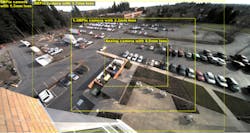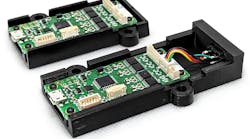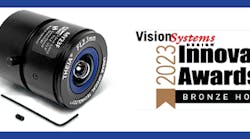“I want a lens that can cover the whole parking lot and I want to be able to read a license plate.” Sound familiar? As a manufacturer of wide-angle lenses, Theia Technologies is frequently asked if we have a product that allows the user to do both of these things simultaneously.
The answer is, “it depends.” It depends on several variables: The resolution you start with from the camera; how far away the subject is from the lens; and the field of view of the lens. But keeping the first two variables constant, the impact of the lens field of view becomes clear.
When buying analog cameras, you and your customers were concerned about darkness, glare, rain and other factors but seldom gave the lens a second thought. With today’s high-resolution and megapixel cameras, the lens might be the most important accessory to specify with each megapixel camera. After all, if the lens does not provide the resolution that the camera is capable of producing, your client is wasting their investment in higher-resolution cameras.
Image Resolution vs. Field of View
One of the important factors to consider when designing video surveillance installations is the trade-off between lens field of view and image resolution. With any given combination of camera and lens, the native resolution from the camera is spread over the entire field of view of the lens, determining pixel density and image resolution. The wider the resolution is spread, the lower the pixel density, the lower the image resolution or image detail.
The images in Figure 1, taken with the same camera from the same distance away, illustrate this trade-off. The widest field of view can cover the widest area, but it does not allow a user to see high detail; while the narrowest field of view permits capture of high detail at the expense of wide area coverage.
So, your client would like to cover a whole parking area, but unfortunately, they are not able to read the license plate. What to do? At this point, there are two variables that you may be able to change in your system design to improve image detail:
1. Distance from the camera to the subject: If possible, the installer can improve the image detail by moving the camera closer to the subject. This may be feasible in a new installation, but in an existing system, this may be limited by the physical constraints of the location and the system itself, along with costs associated with re-cabling. Moving closer improves the image detail, but field of view is reduced.
2. Change the camera resolution. By selecting a higher-resolution camera with a higher starting number of pixels and spreading them over the same field of view as before, the pixel density will be higher and the resulting image detail will be better. Of course, this assumes you can make that change in the system and your client can support the likely higher priced hardware and data storage needs required with higher-resolution systems. The higher resolution, data intensive cameras will also lower the frame rate of the system which must also be kept in mind especially with industry specific standards and requirements.
Tools of the Trade
There are many useful tools available to help support systems design and proper equipment selection. One is Theia’s own image resolution and lens calculator, which enables you to input important details of the application and potential equipment, then quickly calculate image resolution with those assumptions. You input the camera resolution and sensor size you intend to use, the lens field of view you believe you need, then input your key project variables — either how much resolution you think you need in terms of pixel density, how much coverage you need in distance (feet or meters), or how far away the camera is from the subject. The tool then calculates the other variables for you.
For example, if you indicate you plan to use a 5-megapixel 1/2.5” sensor camera, a 3mm lens and you will be 50 feet away from your subject — the tool will calculate your pixel density, which in this case would be 27 pixels/foot; and coverage width , which would be 97 feet wide. The tool then provides an image that represents the level of image resolution you would get for your selected variables, allowing you to quickly see if you have enough resolution to meet the needs of your application.
The latest smartphone and tablet versions of the calculator app include enhancements that allow users to input the camera height and/or camera angle — so you can tell if a person’s head, for example, will be covered in the image given different distances from the camera. The latest version also allows the user to introduce a level of jpeg noise so that the resulting image more accurately reflects real-world conditions.
How the Lens Influences the Image
If you decide to increase image resolution by increasing the camera resolution, you must also consider lens selection. The lens needed for an IP/megapixel camera is much different than the lens needed for a traditional analog camera. These higher-resolution cameras demand high-performance lenses in order to take full advantage of the increased resolution.
For example, in a megapixel camera, the focal plane spot size of the lens must be comparable or smaller than the pixel size on the sensor (See the “Focal Planes” illustration), otherwise the light falls off the pixel, resulting in a fuzzy image.
Using a standard-resolution lens with a 5-megapixel camera will produce a blurry image. Most often, if you want to take advantage of all the pixels a multi-megapixel camera provides, a high-quality lens with matching resolution is needed — otherwise the money spent on a high-resolution camera is wasted.
Still, it is not as simple as specifying a megapixel lens for a megapixel camera; in fact, in many cases it can be quite difficult to ensure that the lens needed is the lens being offered. Many manufacturers refer to a product as a “megapixel lens” but they seldom define what the adjective “megapixel” means. Is that “MP” lens to be used with a 1.3 megapixel camera or a 3 megapixel camera? Can it be used with all megapixel cameras?
In megapixel cameras, the pixel size and the required lens spot size varies depending on the size of sensor and quantity of pixels it contains. You can have two different cameras — both 1.3 megapixel — but if the sensor size is not the same, the pixel size will be different, as illustrated in the graphic.
In selecting a lens, it is important to choose one that is designed for use with both the sensor size and the resolution of the camera. Over-specifying the lens to have a higher megapixel rating than the camera is acceptable — it ensures the lens is not the resolution limiting factor in the system.
Higher megapixel cameras with their smaller pixels need lenses with more internal glass elements and higher precision elements than lower megapixel models. These superior lenses should deliver the greater performance required for higher megapixel cameras.
For more information on how to select and specify a lens, read the full whitepaper at www.theiatech.com/papers.php?name=Lens_selection; or contact Theia Technologies: (503) 570 3296, or [email protected].
Andrea Iniguez is VP of Business Development for Theia Technologies. To request more info about the company, please visit www.securityinfowatch.com/10215759.



